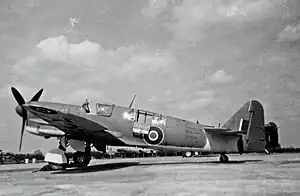| 795 Naval Air Squadron | |
|---|---|
| Active | 1942-43 1946-47[1] |
| Country | |
| Branch | |
| Part of | Fleet Air Arm |
795 Naval Air Squadron (795 NAS) was a Naval Air Squadron of the Royal Navy's Fleet Air Arm.
History of 795 NAS
Eastern Fleet Fighter Pool (1942 - 1943)
795 Naval Air Squadron formed at RNAS Tanga (HMS Kilele), Tanganyika, East Africa, on 24 June 1942 as the Eastern Fleet Fighter Pool. It was initially equipped with Fairey Fulmar, a British carrier-borne reconnaissance and fighter aircraft, and Grumman Martlet, an American carrier-based fighter aircraft.[2] As part of the Battle of Madagascar, 'A' Flight, which was formed of six Fairey Fulmar aircraft, embarked in HMS Illustrious along with the Fairey Albacore biplane torpedo bomber equipped 796 Naval Air Squadron, on 29 August.[3] On 11 September the flight was put ashore at Majunga, Madagascar and was tasked to provide anti-submarine patrols, under the direction of No. 207 Group RAF.[2] The Flight undertook a number of active sorties but in November it moved to the ex-seaplane tender HMS Albatross.[3] The main section of the squadron had moved to RNAS Mackinnon Road, in Kenya, East Africa, on 19 September 1942 and remained there for almost a year. 795 Naval Air Squadron disbanded on 11 August 1943.[4]

Refresher Training Squadron (1946 - 1947)
795 Naval Air Squadron reformed as a Refresher Training squadron, on 1 August 1946 at RNAS Eglinton (HMS Gannet), and as part of the 52nd Training Air Group. The squadron was equipped with Fairey Firefly, a carrier-borne fighter aircraft and anti-submarine aircraft. Its role was to provide refresher training to aircraft carrier standard. On the 13 November 1946 the squadron exchanged Commanding Officer and staff with 719 Naval Air Squadron, then on 14 January 1947, the squadron embarked in HMS Implacable.[3]

795 Naval Air Squadron disbanded for the second time on 24 March, the squadron disembarked from Implacable to RNAS Ford (HMS Peregrine),[5] it’s aircraft flown to RNAS Stretton (HMS Blackcap), to be put into storage, on the same day.[3]
Aircraft flown
The squadron has flown a number of different aircraft types and variants:[3][6]
- Fairey Fulmar Mk.II carrier-based reconnaissance/fighter aircraft (May 1942 - June 1943)
- Grumman Martlet Mk I carrier-based fighter aircraft (1942)
- Grumman Martlet Mk II carrier-based fighter aircraft (September 1942 - April 1943)
- Grumman Martlet Mk III carrier-based fighter aircraft (November 1942 - August 1943)
- Grumman Martlet Mk IV carrier-based fighter aircraft (June - August 1943)
- North American Harvard Ila advanced trainer aircraft (June - September 1943)
- Hawker Sea Hurricane Mk IB fighter aircraft (December 1942 - January 1943)
- Fairey Firefly FR.I carrier-borne fighter, strike fighter and aerial reconnaissance aircraft (August - November 1946, November 1946 - March 1947)
References
Citations
- ↑ Sturtivant & Ballance 1994, p. 119.
- 1 2 Wragg 2019, p. 138.
- 1 2 3 4 5 Ballance, Howard & Sturtivant 2016, p. 96.
- ↑ "Mackinnon Road". Royal Navy Research Archive - Fleet Air Arm Bases 1939 - present day. Retrieved 15 January 2024.
- ↑ "Ford". Royal Navy Research Archive - Fleet Air Arm Bases 1939 - present day. Retrieved 15 January 2024.
Bibliography
- Ballance, Theo; Howard, Lee; Sturtivant, Ray (2016). The Squadrons and Units of the Fleet Air Arm. Air Britain Historians Limited. ISBN 978-0-85130-489-2.
- Sturtivant, R; Ballance, T (1994). The Squadrons of The Fleet Air Arm. Tonbridge, Kent, UK: Air-Britain (Historians) Ltd. ISBN 0-85130-223-8.
- Wragg, David (2019). The Fleet Air Arm Handbook 1939-1945. Cheltenham, Gloucestershire, UK: The History Press. ISBN 978-0-7509-9303-6.